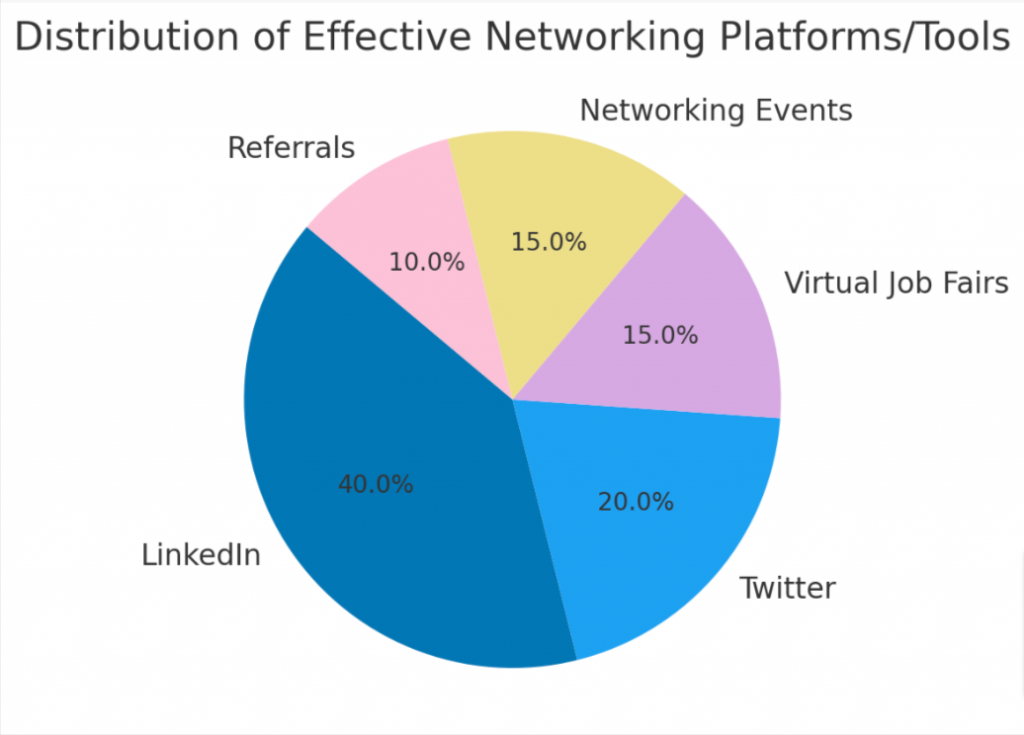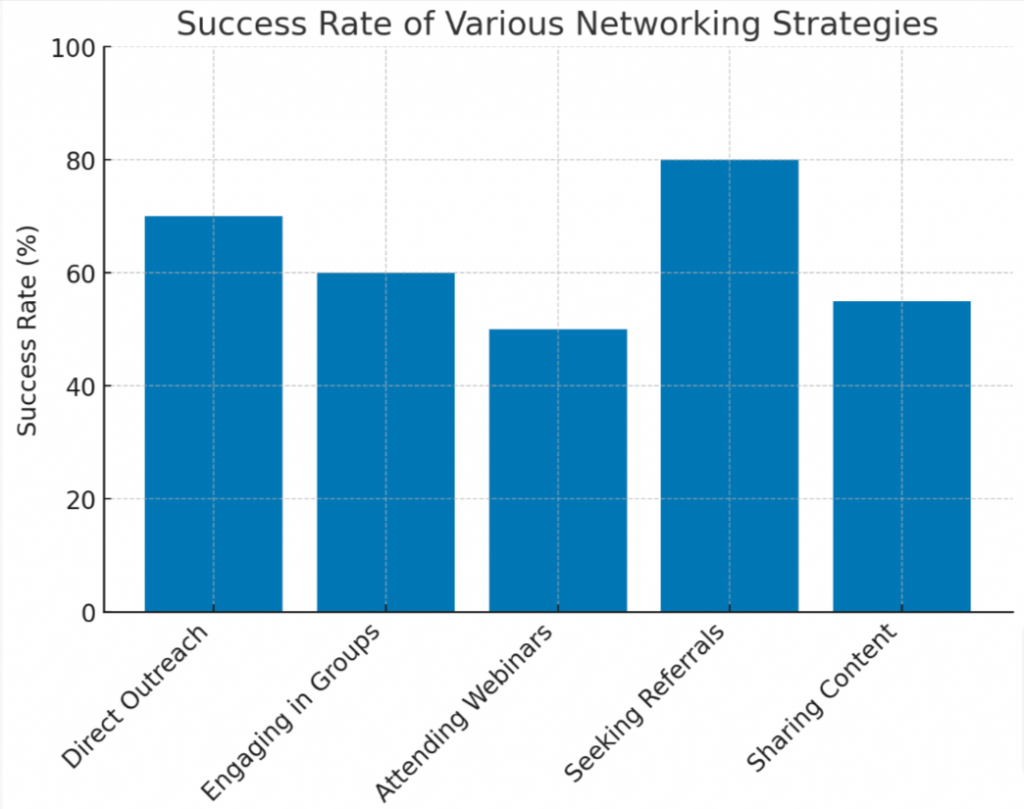Building Digital Bridges: Networking Strategies for the Remote Job Market
Introduction
In a world where “it’s not what you know, but who you know” reigns true, networking has solidified its position as a cornerstone of professional growth. Whether you’re a fresh graduate or a seasoned professional, forging connections can be the key to unlocking doors of opportunities. But as work environments evolve, with remote jobs gaining unprecedented traction, the art of networking faces a new frontier.
The digital realm, vast and intangible, presents both challenges and opportunities for job seekers aiming to cultivate meaningful connections.
While face-to-face coffee meetups and traditional networking events have their charm, the digital landscape offers a broader reach, transcending geographical boundaries. However, the absence of physical cues and the sheer volume of online interactions necessitate a refined approach to networking.
This article aims to navigate this digital maze, offering remote job seekers insights, strategies, and best practices to harness the power of online networking effectively. As we delve deeper, we’ll explore how to meld the essence of traditional networking with the versatility of digital platforms, ensuring that your networking efforts are both genuine and impactful in the remote job landscape.
The Evolution of Networking in the Digital Age
Networking, at its core, has always been about forging connections, sharing knowledge, and cultivating opportunities. Historically, these connections were fostered in boardrooms, at conferences, or over business lunches. The personal touch, the handshake, and direct eye contact were deemed essential elements of successful networking. However, as with many facets of our lives, technology has ushered in a transformative shift.
The late 20th and early 21st centuries marked the dawn of the digital networking era. Platforms like LinkedIn, which debuted in 2003, reimagined the concept of professional networking. Suddenly, one could connect with a colleague from a past job, a potential employer from another continent, or an industry expert without leaving their desk. This digital transformation expanded the networking horizon exponentially.

Today, as remote work continues its upward trajectory, accelerated by global events and technological advancements, the significance of digital networking has further amplified. Remote job seekers, unbounded by geographical constraints, now have a global playground. However, this vast landscape also presents a challenge: How does one stand out in a sea of digital profiles? How can one foster genuine connections when interactions are mediated by screens?
The dynamics of networking have undeniably changed. While the foundational principles remain—building trust, offering value, and nurturing relationships—the methods and mediums have evolved. In this new age, networking isn’t just about attending events or exchanging business cards. It’s about crafting a compelling digital narrative, engaging in meaningful online interactions, and leveraging technology to bridge the spatial divide.
The Importance of Networking for Remote Job Seekers
The digital age, with its plethora of platforms and tools, has democratized access to job opportunities. Remote roles, in particular, have become increasingly sought after, promising flexibility, a diverse work environment, and, often, a better work-life balance. However, this surge in interest also means heightened competition. In such a landscape, networking emerges not just as a strategy, but a necessity for remote job seekers. Let’s delve into why networking holds paramount importance in the remote job-hunting journey.
Standing Out in a Saturated Digital Market
Remote job listings often attract applicants from across the globe. For employers, sifting through hundreds, if not thousands, of applications can be daunting. Here, having a personal connection or a recommendation can elevate your application, ensuring it gets the attention it deserves. Networking can be the differentiating factor that sets you apart from the crowd.
Building Genuine Professional Relationships
The essence of networking transcends transactional interactions. It’s about cultivating relationships. In the realm of remote work, where face-to-face interactions are rare, building a network of professionals can provide camaraderie, mentorship, and insights. These relationships can offer guidance, provide feedback, and even lead to collaborations, enriching your professional journey.
Accessing the Hidden Job Market
Not all job openings make it to public listings. Some are filled through internal referrals, while others are shared within closed networks. Networking effectively can give you access to this hidden job market. Being in the right network means you’re more likely to hear about openings even before they’re publicly announced, giving you a head start and reducing competition.
Enhancing Skill Sets and Industry Knowledge
Networking isn’t just about job opportunities. Engaging with professionals in your field can offer insights into emerging industry trends, tools, and best practices. Such interactions can help you stay updated, enhance your skill set, and position you as a valuable asset in the remote job market.
Facilitating Seamless Transitions
For those new to remote work, the transition can be riddled with challenges—from setting up a productive workspace to managing time effectively. Networking with seasoned remote professionals can provide actionable tips, resources, and advice, ensuring a smoother transition.
In essence, networking for remote job seekers is a multifaceted tool. It’s a gateway to opportunities, a source of knowledge, and a support system. As the boundaries between workspaces blur and the world becomes more interconnected, the power of networking becomes even more pronounced, guiding professionals towards success in the vast digital workspace.
Digital Platforms for Networking
In the digital age, the tools and platforms available for networking have expanded significantly. These platforms, each with its unique features and user base, offer varied opportunities for remote job seekers to connect, engage, and foster relationships. Let’s explore some of the most influential platforms and how to utilize them effectively for networking.

LinkedIn has established itself as the premier platform for professional networking. With over 700 million users worldwide, it’s a hub for industry leaders, professionals, and companies.
- Optimizing Your Profile for Visibility: Ensure your LinkedIn profile is complete, with a professional photo, compelling headline, and detailed work experience. Recommendations and endorsements can further bolster your credibility.
- Engaging with Content and Joining Relevant Groups: Actively share, comment on, and engage with industry-relevant content. Joining groups related to your field can also provide networking opportunities and insights into the latest trends and discussions.
- Reaching Out to Industry Professionals: When connecting with someone, personalize your request with a brief introduction or a mention of common interests. Avoid generic messages.

While primarily a microblogging platform, Twitter has evolved into a space for professional discussions, especially in fields like tech, marketing, and media.
- Following Industry Leaders and Engaging in Relevant Discussions: Identify and follow thought leaders in your industry. Engage with their content and participate in discussions to increase your visibility.
- Utilizing Hashtags to Discover Networking Events or Job Opportunities: Hashtags can be instrumental in finding relevant content, online events, or job listings. Regularly monitor hashtags pertinent to your field.
Industry-Specific Forums and Websites
Beyond the mainstream platforms, many niche websites and forums cater to specific industries. Sites like Behance for designers or GitHub for developers offer networking opportunities within specialized communities.
- Engaging in Niche Communities Related to Your Field: Participate in discussions, share your work, and collaborate on projects. Being active in these communities can position you as a knowledgeable professional in your field.
- Sharing Expertise and Seeking Advice: Offer solutions, share experiences, and ask questions. Engaging genuinely can lead to meaningful connections.
Virtual Networking Events and Webinars
The rise of remote work has led to an increase in virtual events, webinars, and conferences. These events offer a goldmine of networking opportunities.

- Finding and Attending Events Relevant to Your Industry: Websites like Eventbrite or Meetup often list virtual events. Choose those that align with your professional interests.
- Making Meaningful Connections During These Events: Engage in discussions, ask questions, and follow up with attendees or speakers post-event. Remember, the goal is to foster relationships, not just gather contacts.
Harnessing the potential of these digital platforms requires a mix of strategy, authenticity, and consistency. While it’s essential to be proactive, it’s equally crucial to ensure that interactions are genuine. In the vast digital networking landscape, meaningful connections often stem from authentic engagements, shared interests, and mutual respect.
5. Best Practices for Effective Digital Networking
While the platforms and tools available for digital networking are diverse, certain universal best practices can amplify your networking efforts. Adopting these practices can ensure that your interactions are meaningful, impactful, and foster genuine relationships. Here are some tried-and-true strategies to enhance your digital networking endeavors:
Personalizing Connection Requests
Generic messages or connection requests can often be overlooked or dismissed. When reaching out to a potential connection, especially someone you haven’t interacted with before, it’s crucial to personalize your message.
- Tips: Mention common interests, mutual connections, or specific content they shared that resonated with you. Demonstrating genuine interest can significantly increase the likelihood of a positive response.
Staying Active and Consistent
Digital platforms thrive on activity and engagement. Merely creating a profile isn’t enough; it’s essential to be consistently active.
- Tips: Regularly share updates, comment on discussions, and engage with content related to your industry. Consistency not only boosts your visibility but also positions you as an engaged and informed professional.
Offering Value
Networking isn’t a one-way street. While it’s natural to seek insights, opportunities, or advice, it’s equally important to offer value to your connections.
- Tips: Share interesting articles, provide solutions to queries, or introduce connections to relevant opportunities. By being helpful and offering value, you nurture and strengthen your professional relationships.
Setting Clear Networking Goals
Without a clear direction, networking efforts can become scattered and ineffective. It’s vital to have specific goals in mind, whether it’s finding a mentor, seeking job opportunities, or expanding your knowledge.
- Tips: Periodically set clear, measurable networking goals. For instance, attending two virtual industry events a month or connecting with five industry leaders in a quarter can give direction to your networking endeavors.
By embracing these best practices, you can navigate the digital networking landscape with purpose and efficacy. Remember, the essence of networking lies in mutual growth and relationship-building. Approach each interaction with authenticity, respect, and a genuine desire to connect, and you’ll find that the digital realm can offer as much warmth, support, and opportunity as any traditional networking event.
Common Networking Mistakes to Avoid
Every journey is riddled with learning curves, and the path to effective digital networking is no exception. While the right strategies can propel you towards meaningful connections, certain pitfalls can hinder your progress. Being aware of these common mistakes can help you navigate the networking realm with greater confidence and efficacy.
Over-promotion
In the zeal to make an impression, it’s easy to fall into the trap of constant self-promotion. However, incessantly talking about oneself or one’s achievements can deter potential connections.
- Pitfall: Oversharing or consistently steering conversations towards your own achievements can come off as self-centered.
- Solution: Strive for a balance. While it’s essential to share your accomplishments, also show genuine interest in others. Engage in active listening and celebrate the achievements of your connections.
Neglecting to Follow Up
Making a connection is just the beginning. The strength of a relationship often lies in consistent engagement and follow-up.
- Pitfall: Failing to reconnect or engage with a new contact can render the initial connection futile.
- Solution: After an initial conversation or interaction, make it a point to follow up. It could be as simple as sharing an article of interest, expressing gratitude for a discussion, or checking in periodically.
Focusing Solely on Quantity over Quality
In the digital realm, where numbers often dominate — from followers to connections — it’s easy to prioritize quantity over quality. However, having hundreds of superficial connections might not be as valuable as having a few deep, meaningful relationships.
- Pitfall: Amassing connections without genuinely engaging with them can lead to a shallow network.
- Solution: Focus on the quality of interactions. Instead of merely adding connections, invest time in getting to know individuals, understanding their expertise, and fostering mutual growth.
Overlooking Networking Etiquette
Digital platforms might offer a more informal setting compared to traditional networking events, but etiquette remains crucial.
- Pitfall: Being too casual, using excessive jargon, or not respecting time zones can hamper your networking efforts.
- Solution: Maintain professionalism in interactions, be respectful of time differences when scheduling calls, and avoid using overly technical or industry-specific jargon unless certain the other party is familiar.
e. Not Staying Updated The digital landscape is ever-evolving. Platforms update, new tools emerge, and industry trends shift. Staying static in such a dynamic environment can impede effective networking.
- Pitfall: Relying solely on outdated platforms, tools, or techniques.
- Solution: Stay abreast of industry news, participate in webinars, and be open to exploring new platforms or tools that gain popularity.
Avoiding these common pitfalls can significantly enhance your digital networking experience. By approaching networking with a mix of strategy, authenticity, and awareness, you can cultivate connections that not only support your professional journey but also enrich it with shared knowledge, opportunities, and growth.
The Art of Virtual Networking Etiquette
While the core principles of networking remain consistent, the shift to virtual platforms introduces nuances that demand a fresh approach to etiquette. Virtual networking etiquette is the confluence of traditional networking decorum and the unique considerations of digital interactions.
Mastering this art can significantly influence the impressions you make and the relationships you foster. Here’s a guide to ensuring your virtual interactions are both impactful and respectful.
Respecting Boundaries
In the digital realm, where interactions are just a click away, it’s easy to blur the lines between professional and personal, or day and night.
- Consideration: Just because someone is online doesn’t mean they’re available for a work-related chat.
- Best Practice: Schedule virtual meetings in advance, considering the other person’s time zone. If you’re reaching out to someone spontaneously, always start by asking if it’s a convenient time.
Being Authentic
Digital interactions, devoid of physical cues, can sometimes feel impersonal. Authenticity becomes pivotal in bridging this gap.
- Consideration: Form letters or generic messages can come across as insincere.
- Best Practice: Personalize your messages. Share genuine compliments, express authentic interest, and engage in meaningful discussions rather than surface-level chats.
Staying Professional
The informality of certain platforms might tempt one to adopt a casual tone. However, professionalism remains paramount, especially in initial interactions.
- Consideration: Casual language, emojis, or internet slang can be misinterpreted, especially across cultural or age differences.
- Best Practice: Maintain a professional tone, especially with new connections. As the relationship evolves, you can gauge the level of formality suitable for subsequent interactions.
Valuing Time
In a world where back-to-back virtual meetings have become the norm, respecting and valuing others’ time is crucial.
- Consideration: Extended meetings or delays in starting a scheduled call can be disruptive.
- Best Practice: Always start and end virtual meetings on time. If you foresee a delay, communicate in advance. Keep meetings concise, respecting the agreed-upon duration.
Following Up Post Interaction
Virtual interactions, especially those in larger groups or webinars, can be fleeting. Ensuring they leave a lasting impact often hinges on the follow-up.
- Consideration: Without a follow-up, a promising interaction can quickly fade away, lost in the deluge of digital communications.
- Best Practice: After a virtual event or meeting, send a thank-you note or a brief recap. Expressing gratitude or sharing key takeaways can solidify the connection and pave the way for future interactions.
Mastering virtual networking etiquette is about striking a balance between the time-honored principles of respect, authenticity, and professionalism, and the unique dynamics of digital interactions. As you navigate the virtual networking landscape, let these guidelines serve as your compass, ensuring your interactions are as meaningful as they are courteous.
Leveraging Networking for Remote Job Opportunities
Once you’ve cultivated a robust and genuine network, the next step is to leverage it effectively to unearth remote job opportunities. A strong network can not only guide you to advertised positions but also provide insights into roles that might not yet be public. Here’s how to tap into your network’s potential:

Seeking Referrals and Recommendations
Often, companies value internal referrals, trusting their employees’ judgment to bring in potential candidates.
- Consideration: A recommendation from a trusted connection can significantly elevate your application.
- Best Practice: If you’re eyeing a particular role in a company where a connection works, approach them. Share your interest and ask if they’d be comfortable referring you. Ensure you provide them with all the necessary information about your qualifications and why you’re a good fit.
Engaging in Informational Interviews
These are informal discussions with professionals in your industry or desired role, providing insights into job opportunities, company cultures, and industry trends.
- Consideration: An informational interview isn’t about directly seeking a job but gathering information.
- Best Practice: Approach connections expressing genuine interest in their role or industry. Ask open-ended questions, listen actively, and thank them for their time. These interactions can sometimes lead to job leads or further referrals.
Collaborating on Projects or Freelance Opportunities
Before landing a full-time remote role, collaborating on projects can help you gain experience, showcase your skills, and expand your network.
- Consideration: Freelance or collaborative projects can serve as a stepping stone to more permanent roles.
- Best Practice: Offer your expertise in online forums, groups, or to your network. Engage in projects that align with your career goals, ensuring you deliver quality work. These collaborations can lead to job offers or referrals.
Tapping into Alumni Networks
Alumni networks can be a treasure trove of connections, often willing to help based on shared educational experiences.
- Consideration: Alumni often have a sense of loyalty and are more likely to assist fellow graduates.
- Best Practice: Join alumni groups on platforms like LinkedIn, attend virtual reunions, and engage in discussions. Express your career aspirations and seek advice or leads.
Staying Updated with Industry News
Staying informed about industry happenings can lead to job opportunities, as companies expanding, launching new projects, or securing funding might be hiring.
- Consideration: Industry news can offer cues about potential job openings.
- Best Practice: Follow industry publications, join relevant groups, and engage with news shared by your connections. If a company catches your eye, approach connections related to it for insights or potential leads.
In essence, leveraging networking for remote job opportunities is about active engagement, consistent communication, and mutual value exchange. As you tap into your network’s potential, remember to offer as much value as you seek, fostering relationships built on trust, mutual respect, and shared aspirations.
Conclusion
The age-old adage, “It’s not what you know, but who you know,” holds undeniable resonance, even in our digitally-driven world. As the realms of work and communication evolve, embracing remote possibilities and virtual platforms, the essence of networking remains steadfast. It’s about forging connections, cultivating relationships, and navigating professional terrains with the collective wisdom and support of your network.
In the expansive landscape of remote job opportunities, a robust and genuine network serves as both a compass and an anchor. It guides you towards hidden opportunities, offers insights into industry trends, and provides the camaraderie of shared experiences. Yet, as with any journey, the approach matters. Effective digital networking isn’t about amassing contacts but about fostering meaningful relationships. It’s about melding the foundational principles of respect, authenticity, and mutual growth with the nuances of virtual interactions.
As we conclude our exploration into effective networking for remote job seekers, it’s essential to remember that every interaction, be it a quick message, a virtual meeting, or an in-depth discussion, is a brick in the edifice of your professional journey. By approaching networking with intentionality, genuine interest, and a spirit of collaboration, you pave the way for a fulfilling and successful remote career.
So, arm yourself with the insights and strategies shared, dive into the digital networking realm, and remember: In the vast world of remote work, your network is your most valuable asset. Harness its potential, nurture its growth, and let it lead you to the remote opportunities you aspire to.
Call to Action
As we journey through the intricate maze of digital networking, it’s crucial to remember that growth is both an individual endeavor and a collective effort. The strength of the online community lies in its shared experiences, wisdom, and collaborative spirit. As you stand poised to harness the power of networking in your remote job-seeking journey, here are some actionable steps you can take to both contribute and benefit from this vibrant community:
1. Share Your Journey: If this guide has provided you with valuable insights, consider sharing it within your circles. By spreading the word, you not only empower others with knowledge but also play a pivotal role in strengthening the collective wisdom of the remote job-seeking community.
2. Engage Below: Have you stumbled upon a unique networking strategy that wasn’t covered here? Or perhaps you’ve faced challenges that you’d like insights on? Use the comments section below to share your experiences, ask questions, and engage with fellow readers. Your insights could be the beacon that guides someone else.
3. Stay Connected: The world of remote work and digital networking is dynamic. To stay abreast of the latest trends, best practices, and opportunities, consider subscribing to our newsletter or joining our dedicated forum. Let’s continue the conversation and grow together.
4. Pay It Forward: Remember the times when a connection’s insight, a mentor’s guidance, or a peer’s recommendation made a difference in your journey? It’s now your turn to pay it forward. Offer help, provide recommendations, and be there for your connections. The ripple effect of such gestures can have far-reaching impacts.
5. Dive In With Confidence: Armed with knowledge, strategies, and a supportive community, dive into the world of digital networking with confidence. Reach out, engage, and remember: every interaction is a step towards your next opportunity.
In conclusion, the path to effective digital networking and successful remote job seeking is both a journey and a destination. Every connection you make, every strategy you employ, and every challenge you overcome adds to your narrative. Let’s craft this story together, one interaction at a time. Start today, engage with the community, and let’s collectively pave the way for a brighter, connected, and opportunity-rich future in remote work.

